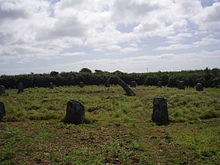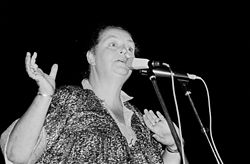St Buryan
The parish is dotted with evidence of Neolithic activity, from stone circles and Celtic crosses to burial chambers and ancient holy wells.
The bells of St Buryan's Church, which have recently undergone extensive renovation, are the heaviest full circle peal of six anywhere in the world.
St Buryan Village Hall was also the former location of Pipers Folk Club, created in the late 1960s by celebrated Cornish singer Brenda Wootton.
Further to the south the terrain slopes down toward the sea, ending in several deep cut river valleys at Lamorna, Penberth and St Loy that are both sheltered and heavily forested.
East of the village the land also slopes away toward Drift, and its reservoir, past the wooded area at Pridden and the deep cut valley at Trelew (in which a steep embankment has been built to carry the B3283 road).
The legend states that Saint Piran prayed through the night whilst the snow fell, and in the morning Geraint was awoken by a cuckoo's song.
In addition to menhirs there are 12 stone crosses within the parish,[9] including two fine examples in St Buryan itself, one in the churchyard, and the other in the centre of the village.
It is thought that many of these are pagan in origin, dating from the Neolithic and later periods, but were adapted by the early Christian church to remove evidence of the previous religion.
Only several hundred yards from the site of the Merry Maidens lies a Bronze Age burial chamber, Cruk Tregyffian, that was discovered (and unfortunately damaged) during widening of the adjacent B3315 road.
Further east along the B3315 road, and only 1 mile (1.6 km) from Lamorna, lies the Boleigh Fogou, considered to be one of the best remaining monuments of its kind in Cornwall.
[13] The fogou at Boleigh is extensive and has a large entranceway that leads to a long passage with classic dry stone wall and lintel construction.
A revolt against the Anglo-Saxon English in 931 AD by the Cornish Celts (supported by the Danes) led to a battle southeast of the village at Boleigh where a farm and hamlet now stands.
"[15]St Buryan was visited by King John in the early 13th century who, after landing at Sennen from Ireland, travelled to the parish to stay the night.
The purpose of the visit was an inspection of local mining works in the area and resulted in the import of German engineers to improve their efficiency.
[14] Perhaps one of the most notable residents of St Buryan during the seventeenth century was one William Noy, an MP (Grampound 1603–1614, Fowey 1623–1625 and Helston 1627–1631)[16] and member of the court of King Charles I, who was born and lived on the Pendrea estate within the parish.
High rates of duty were levied on imported wine, spirits, and other luxury goods to pay for Britain's expensive wars with France and the United States.
Cornwall was a haven for smugglers at this time, with its many secluded coves ideally suited for evasion of the duty, a smuggling provided a highly profitable venture for impoverished fishermen and seafarers.
This was in part due to the destruction of the collegiate buildings during The Protectorate period after the English Civil War[20] and also the gradual weakening of the political position of the Church of England that occurred during the eighteenth and nineteenth centuries.
This loss of importance is reflected in the fact that the proportion of the district's population living in the parish fell from four and a half to less than two percent over this period.
After a spike in population in the early 19th century that is mirrored across the district and coincides both with the arrival of the railways and increased tin mining activity in Penwith, the population of the parish gradually declined over the next two hundred years (see figure right), in part due to the increased mechanisation of farming that the industrial revolution brought, requiring fewer people to work the land.
A newly formed company, Zennorin Developments Ltd applied to reopen the pits in 1970, but was rejected on the grounds that it would spoil an area of outstanding natural beauty.
In common with other settlements in the district such as Newlyn and Penzance, the post-war period saw the building of a council estate to the west of the village on land formerly part of Parcancady farm.
[23][24] St Buryan has a long history of religious activity both through its historical connection with the church of the state, and later playing an important part in the Methodist revival of the 18th century, led by John Wesley who visited the parish and ministered on several occasions.
[4][25][26][27][28][29] Owing to the nature of the original Charter from King Athelstan, the parish of St Buryan was long regarded as a Royal Peculiar thus falling directly under the jurisdiction of the British monarch as a separate diocese, rather than the Church.
[30] Only two of the King's appointed Deans appear to have actually lived in the diocese of St Buryan for more than a few months, and the combination of these factors led to the subsequent ruinous state of the church in 1473.
[36] In its 2004 Ofsted inspection pupils' standards of achievement were classed as good overall with above average results in Science and English and very high attainment in Mathematics.
The modern Gorsedd has subsequently been held nine times in the parish including on the fiftieth anniversary, both at Boscawen-Un and at The Merry Maidens stone circle.
[38] The feast of St Buriana is celebrated on the Sunday nearest to 13 May (although the saint's official day is 1 May) consisting of fancy dress and competitions for the children of the village and usually other entertainments later in the evening.
Its central location in west Penwith and proximity to popular tourist attractions such as the Minack Theatre, Land's End and the Blue Flag beach at Sennen Cove,[51] mean that St Buryan enjoys a healthy income from visitors, both day trippers and those renting accommodation, during the summer months.
The village was also previously served by its own butchers shop, this was closed in 1990 due to combination of the economic recession and pressure from the recently opened Safeway(now Morrisons) supermarket in nearby Penzance.















